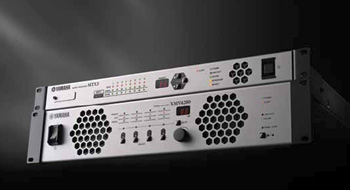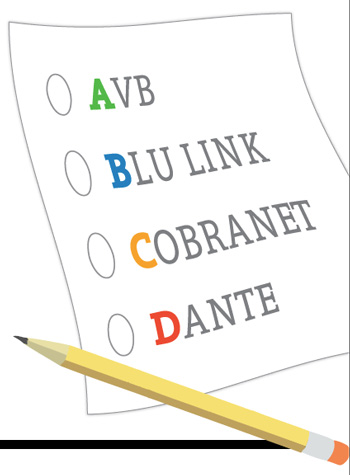How Do You Decide Which Audio Networking System is Best For Your Application
Tech managers and facility directors contemplating the purchase of an audio network are faced with a potentially confusing list of choices. Happily, Adam Holladay, market manager, system development and integration group at Harman, recently adopted a marketing slogan—“audio networking as easy as A, B, C, D”— that conveniently focuses attention on some of the more popular transports and protocols.
Holladay coined the tagline to describe Harman’s latest iteration of its HiQnet software program, Audio Architect, which combines System Architect and London Architect functionality and enables the configuration— through a single GUI—of AVB, Harman BLU link, CobraNet, and Dante audio networking protocols supported by the company. “The idea of networking is fairly daunting to those who haven’t done it; it’s not easy unless you’re an IT expert,” commented Holladay. With Audio Architect, he said, “You need only learn the one software application.”
OPTIONS APLENTY
There are plenty of other networking schemes available. Yamaha, for example, supports what may be the widest range of protocols of any pro audio manufacturer via its interface cards: AVB (Audio Video Bridging), CobraNet, Audinate’s Dante, and EtherSound versions, all of which Yamaha distributes, plus Aviom’s A-Net, Optocore and Riedel’s RockNet cards, which are distributed by the respective manufacturers.
So how do you decide which networking system is best for your application? “They all have their strengths,” said Steve Seable, DSP and amplifier product manager at Yamaha Commercial Audio. Potential users typically compare latency, channel count or other technical specifications, said Seable. “But what it really comes down to is the devices that manufacturers have created that meet your needs.” For example, if a user needs to be able to break out of the network into a piece of equipment with a specific connector but no one makes an appropriate hardware interface, then that network might be unsuitable.
DETERMINING ROI
There are two things to consider when determining the ROI of a given network, believes Kevin Ivey, General Manager, Peavey Commercial Audio. Peavey’s MediaMatrix and Crest Audio products support CobraNet and Dante. As a member of the AVnu Alliance, the consortium of 47 manufacturers working on the AVB open standard, Peavey is also keeping a watchful eye on that protocol’s development.
“First of all, the scope of your project; that includes what you anticipate your workflow to be and what you consider that traffic to be, in terms of how you size the network, and how many inputs and outputs you’re going to require,” said Ivey. “Then, segregate the AV traffic from the control traffic on the network. Keep the infrastructure simple. This allows you to enjoy all the benefits of a distributed network system without the hassle of individual analog and serial connections.”
When considering whether or not a particular network is appropriate, “I think the best thing to look at is what you gain from running your AV systems over a network versus over analog cabling,” continued Ivey. “The embedded and extended control and monitoring, and the ease with which you can scale the network, and thus the size of your project, needing little more than a network switch and a length of Cat-5/5e/6 cable to jump to the next device, are certainly important considerations.”
WHEN NETWORKS DON’T APPLY, TAKE THE BUS
Not every application demands a network solution. Several manufacturers, including Harman, Peavey, and Yamaha, offer proprietary bus connections that may suffice. Harman’s BLU link, for example, allows two BSS Soundweb London boxes (now extendable to Crown amplifiers with the PIP-BLU module fitted) to share 256 channels (at 48 kHz; 128 at 96 kHz) over Cat-5e cable, without requiring a switch.

The Yamaha CIS products use Dante technology and the company’s YDIF cascade bus.“But,” said Peavey’s Ivey, “once you add that first configurable audio bridge and you begin to realize you can use one or two [MediaMatrix] NIONs and take care of all the inputs and outputs in eight courtrooms in a facility, or multiple classrooms in a school, then the savings become immediately apparent.” For a system encompassing 32 or more channels, he said, “You should start considering what a networked system would look like and what it might be able to save.”
FOR LARGE-SCALE DEPLOYMENTS
For more complicated, larger systems, the network switch as it relates to the network protocol may ultimately offer the differentiator between two or more product choices. Network switches are typically described as “layer two” or “layer three,” nomenclature taken from the seven layers—layer one is the physical layer, or electrical interface—defined by the OSI (Open Systems Interconnection) standards body in the late 1970s. Without getting bogged down in technical details, layer two switches are relatively simple, automatically learning the destination port to which each packet of data needs to be forwarded, or switched, and thus requiring no management. Layer three switches are more complex, capable of handling IP addresses and routing data between subnets. They require greater processing power than a layer two switch (and therefore cost more) and configuration via a GUI.
“AVB is a layer two solution,” said Holladay. “That’s how it manages to achieve its inherent protection of audio and video data.” AVB’s design offers guaranteed Quality of Service (QoS), latency and data synchronization.
MAKING YOUR IT DEPARTMENT HAPPY
“Being layer three and IP data, Dante in essence rides on top of the lower level Ethernet protocols and has to do all of that work itself. Manual intervention is often therefore required to guarantee arrival of the audio,” Holladay continued. “So AVB is probably the better entry point for the less experienced. As it stands today, when the IT department has mandated that audio is routed over IP, then Dante becomes the more suitable solution.”
Using Dante, “You can combine up to 40 subnets,” said Seable. “It’s the only network protocol that really spans subnets well. For massive campus-wide networks, that’s a good feature.”
But, Seable warned, “The best practice is to not converge audio with other traffic.” In a large sports venue network, for instance, administration, point of sale and other traffic could interrupt audio data and limit the available bandwidth. “If you can be separate then it does give you more control, and it’s less work when you’re troubleshooting,” added Seable.
“One of Audinate’s claims is zero configuration needed, and in most cases that’s true,” said Ivey. “Being that it’s fully TCP/IP compliant it can work on legacy switchgear and is a bit more versatile and flexible; it’s somewhat future proof as a result.” Audinate has also designed Dante using technologies that, according to the company, will offer customers compatibility with AVB as that protocol becomes more widely implemented.
ETHERNET AND AVB
CobraNet, too, uses standard Ethernet hardware (both are layer two). “It uses a lot of legacy switchgear,” said Ivey, and is easily managed once set up. As the first commercially successful networking protocol to market, CobraNet enjoys a very large install base. But with no TCP/IP capability and limited to 32 bi-directional channels of audio, it is not suitable for every installation.
“In working with AVB for over five years now, and having taken various platforms through 10 AVnu Alliance plugfest events to date, it is ready for primetime,” reported Lee Minich, AVnu Alliance MWG chairman and president of Lab X Technologies. Multiple manufacturers demonstrated AVB interoperability at InfoComm 2012.
AVB’s audio protocols have been ratified and the control protocol has been submitted for approval. AVnu Alliance’s AVB switch certification is slated for Q4 2012 and audio endpoint certification is reportedly on track for Q1 2013. Three manufacturers—BSS Audio, Extreme Networks and Lab X Technologies—are currently in production with dedicated AVB switches, which are essential for access to the platform’s full benefits.
“AVB-based products for video are underway, and being a widely applicable technology it is being adopted in automotive and ultimately in consumer, both wired and wireless applications,” added Minich. The professional AV market will most likely adopt AVB first and has been very accepting of the technology, said Minich, because of its experience with the deployment challenges of proprietary solutions during the past 15-plus years.
“AVB will ultimately ‘take off’ in automotive followed closely by consumer electronics due to sheer volumes,” he predicted. “This is ultimately a win for the professional applications due to the economy of scale and breadth of design options.”
Steve Harvey (psnpost@nbmedia.com) has been West Coast editor for Pro Sound News since 2000, and also contributes to TV Technology and Pro Audio Review. He has 30 years of hands-on experience with a wide range of audio production technologies.
Support Considerations
Configuration and support is a critical issue in an installed network. In an organization with limited expertise or human resources a network offering plug-andplay configuration and operation, such as AVB, might be preferable to a proprietary product such as CobraNet or a layer 3 managed solution such as Dante.
“You would find that the level of ability of on-site staff could be much lower with AVB than with Dante or CobraNet,” said Holladay. “If there’s a problem within an AVB system, somebody ought to be able to troubleshoot and rectify it far more easily than if there was a comparative problem with Dante or CobraNet.”
In a larger venue, where a layer 3 solution would be more appropriate, there will typically be a dedicated IT department or independent IT contractor to manage the audio network or subnet.
The training offered by manufacturers is largely limited to operation of their respective software applications. “We can ensure that when someone leaves one of our training courses they’re capable of configuring any one of the four solutions supported by Harman,” said Holladay.
Peavey’s training is slightly broader, according to Ivey: “One of the things we do cover in our two-day MediaMatrix training is rudimentary network design and how best to optimize the network for audio and control traffic.”
—Steve Harvey
Decisions, Decisions
“We really just went with standards from the IT industry, such as IEEE 1588, rather than trying to invent something specific for our industry,” said Rich Zwiebel of Q-LAN, the networking technology behind QSC’s Q-Sys products.
Zwiebel, VP, systems strategy for QSC Audio and president of Colorado-based K2 Audio, was the founder of the company that in 1996 introduced CobraNet, now an industry standard audio network. “At that point we had no choice; we had to invent things. The most common question then was, ‘You want to put audio over Ethernet? You can’t do that—and why would you want to?’”
The QSC system is based on Intel processors, uses offthe- shelf layer 3 switches, and automatically finds all of the components on the network. “Some of the switches are cheap; you can go down to Best Buy and get them. We think that’s a huge advantage. If you take something like AVB, that doesn’t work so well with existing switches; I think that’s a drawback,” commented Zwiebel.
Q-LAN integrates with Cisco’s StadiumVision video and digital content distribution system, said Zwiebel. “You can have the audio, the video, and the control running together and interoperating with each other. So we’re tied into all kinds of video products, control and point of sale stuff. That allows us to interoperate with things outside the pro audio industry. That does differentiate us.”
The system is also eminently scalable, he noted: “There’s no limit, really, to the size of the network when it’s a layer 3 network.”
Ultimately, however, the network is simply a means to an end: “In time the networks should become less of an issue. I think you want to focus on what you’re trying to achieve.”
